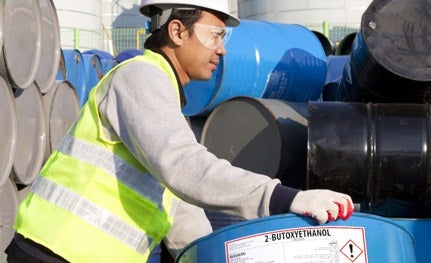Key mandates for chemical manufacturers and transporters
The Globally Harmonized System of Classification and Labeling of Chemicals is a global system for hazard classification and chemical hazard communication. GHS serves as a guide for labeling chemicals and hazardous materials for the purpose of establishing a common infrastructure for communicating unified information to users of chemicals globally. The ultimate goal of GHS is to help improve and protect human health and the environment.
In addition to meeting GHS standards for drum label content, distributors who ship chemicals via ocean freight are required by the International Maritime Dangerous Goods (IMDG) Code to use British Standard (BS) 5609-certified pressure-sensitive, adhesive labels.
As a result of these two mandates, many chemical companies around the world are transitioning from thermal printing of black-and-white shipping labels to more sophisticated on-demand, in-house printing of multi-color shipping labels using thermal transfer, laser, inkjet or other digital print technologies.
Why Teslin label material is preferred for GHS-compliant drum labels for chemicals and hazardous materials
Because of its unique microporous structure, Teslin substrate offers performance benefits that cannot be matched by other label substrates. The combined and exclusive performance advantages of Teslin substrate for GHS labels include:
- Print compatibility and versatility
Teslin substrate accommodates a wide range of high-temperature and digital color printing technologies, including laser, inkjet and thermal-transfer printing. This can help chemical companies transition from thermal transfer printing of black-and-white chemical drum labels to digital printing of GHS-compliant labels using the same label paper and label material.
- Static resistance for increased productivity and enhanced workplace safety
Many synthetic substrates are vulnerable to static build-up. Excess static can cause a number of throughput problems for digitally-printed labels, from sticking together during printing to adhering to themselves when liners are peeled during application. Electrical currents have the potential to shock or injure press operators, or to spark fires in volatile chemical environments. The micropores in Teslin label material absorb and dissipate static, improving print throughput and quality, minimizing losses from wasted productivity, consumables and labels, and reducing the potential for electrical discharge for enhanced workplace safety. (Teslin substrate passes ESDS.541 at 50 percent relative humidity).
- Security and durability of printed data
Teslin label material protects shipping data on GHS labels in two ways. First, the microporous surface absorbs inks and toners, locking printed information into the label material and rendering it nearly impervious to scrapes, scuffs and other damage. Second, Teslin substrate readily bonds to numerous adhesive systems, enabling customized label solutions that bind to a wide range of demanding packaging surfaces.
- Chemical and water resistance
Teslin substrate has earned BS 5609 label certification for chemical and water resistance and immersion in seawater.
- Faster production
Micropores facilitate fast-drying of inks and toners to accelerate production throughput compared to substrates that require specialty inks and toners or longer dry times.
- Lamination strength
Teslin substrate bonds with adhesive and laminating films, expanding the range of options available for durable, customized, specialty label solutions.
Contact us to request samples and learn more about the high-performance benefits of Teslin label mat for GHS-compliant chemical drum and container labels.


